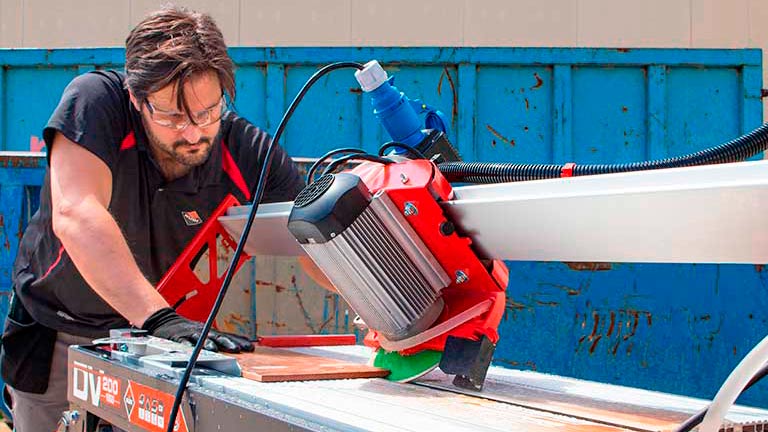Experience has shown that professional tile installers often prefer manual cutters. The appeal lies in their cutting speed, cost-effectiveness, and the ability to work in a clean, comfortable environment. However, with the rise in tile formats and the increased hardness of materials like porcelain and stoneware, many professionals are now turning to electric tile cutters for innovative solutions.
In this article on how to tile, we’ll take you through the different types of electric tile cutters and how you can use them.
The different types of electric tile cutters offer a wide variety of possibilities. Knowing how to distinguish between them will allow you to choose the most suitable model for your needs.


Highlights of Electric Tile Cutters
Before going into the various types of electric cutters available in the market, let’s look at the advantages an electric cutter offers compared to a traditional manual cutter.
Electric cutters allow you to cut a wider range of materials. They can cut the same ceramic tile materials as a manual cutter. They also allow you to work with natural stones and other construction materials.
Another aspect is the great variety and versatility of cuts that an electric cutter offers beyond the traditional straight, orthogonal and diagonal cuts of a manual cutter. With the right electric cutter, you can make precise mitre cuts, and “L” or “U” shaped cuts to save corners or recesses in partition walls or door frames. And don’t overlook the capability for creating grooves or vertical cuts, especially if your cutter features the sought-after mitre effect.
Last but not least, it is important to highlight the quality of the final finish offered by an electric cutter. These cutters work with diamond discs and, for the most part, are water-cooled.
By using the appropriate blade, an electric cutter can achieve cuts nearly as precise as the original factory cuts of the pieces. The key benefits lie in the quality and versatility that an electric cutter brings to the table.

Main Types of Electric Tile Cutters
Now that you have seen what an electric cutter can offer compared to a manual one, it’s time to get to know the different types on the market
Basically, there are three main types of electric cutters:
- Portable cutter
- Moving table cutter
- Moving head cutter
PORTABLE CUTTER
Portable electric slicers are self-defined. They are the smallest, lightest and easiest to transport.
This type of cutter is perfect for small repair and renovation jobs, serving as an ideal complement to any manual cutter. It excels in handling special cuts like squares, window or door corners, columns, and more.
One of the great advantages of the portable electric cutters, especially the wet cut ones, is that they allow you to make the cuts directly at the place of installation. This, together with their ease of use and safety, are the key arguments for choosing them over a grinder.
The ND-200 electric tile cutter and mitre saw is a portable, versatile and very powerful cutter. Its small size and light weight make it an ideal electric cutter for carrying out finishes and renovations. With an adjustable stainless steel table that can be set up to 45º for mitre cuts, this tool enables professionals to perform necessary cuts within the same workspace. This feature minimises displacements, corrections, and downtime, enhancing overall efficiency.
MOVING TABLE CUTTER
Now let’s look at the moving table electric cutter.
Due to its design, you can put the material to be cut on the table, which can be moved. This tool is particularly well-suited for cutting various building materials.
Its main advantage is its speed and its capacity to cut materials of a certain thickness, thanks, above all, to the cutting effect.
While electric cutting machines with a mobile table can handle various materials, they are not recommended for cutting ceramic tiles. The design, cutting system, and format limitations may compromise stability, leading to unwanted movements and vibrations over time, directly impacting the quality and precision of the cut.
The DR-350 Cutter is an electric cutter that’s movable and that has a plunge effect, making it ideal for cutting all types of building materials, from bricks and granite to porcelain and ceramic tiles.
MOVING HEAD CUTTER
The third and final type is the sliding head electric cutter.
Unlike the sliding table machines, this tool is recommended for cutting ceramic materials as well as pieces of natural stone or any other type of cladding where the quality and precision of the cut are indispensable.
In the category of electric cutting machines with sliding heads, a crucial distinction lies between those with and without a cutting effect. The standout feature of sliding head electric cutters is their cutting precision. When coupled with the cutting effect, they provide the utmost cutting versatility, making them the most capable electric cutters available.
Electric tile cutters with a mobile head and mitre saw effect allow us to work with many different tile materials including natural stone, as well as with building materials. They also allow us to make a greater variety of cuts, including grooves and vertical cuts.
However, if your primary concern is the quality of tile cutting, especially in straight cuts and the option for mitres, direct your attention to models with sliding heads that do not have the mitre saw effect. These cutters sacrifice the versatility of the previous ones in favour of cutting quality and precision.
We hope you enjoyed this article on how to use an electric tile cutter! For more blogs on RUBI tools click here.


Post a comment